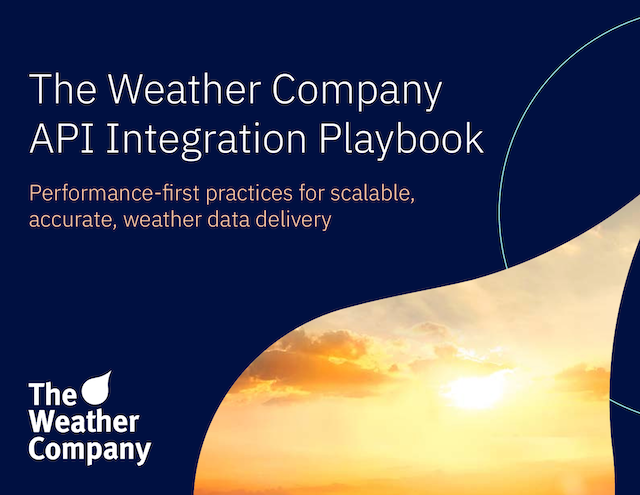Weather intelligence for the future: Crafting a strategic enterprise approach to changing environmental conditions
Continue readingKey takeaways
- The Weather Company Aviation weather APIs help boost safety and enable smarter routing calls with sharper, high-resolution forecasts.
- The platform is built for enterprise-grade integration, offering low-latency, high-scale performance on a secure, cloud-native API architecture.
- The API catalog covers crucial aviation needs, from government-sourced Core data (METARs, TAFs) to proprietary Enroute forecasts (FIP, GTG3, HIWC).
- APIs are available in four distinct output types (Point-based JSON, Raster, Featurizer, and Tiler) for fast data delivery and seamless integration into custom tools.
- New APIs (Tiler Packed, Single Site Radar) enable 3D visualization, significantly reduce payload size, and deliver raw NEXRad Level II data for tactical decision-making.
- The Probabilistic API provides distribution graphs and scenario modeling for risk-based decisions, while the Historical Spatial API supports training and post-event analysis.
Modern airline operations demand access to weather data that supports every stakeholder – from dispatch to crew to passenger. Whether you’re focused on aviation weather flight planning, ramp safety, or customer alerts, the real question isn’t whether you need data. It’s how to integrate it securely, reliably, and at scale.
Aviation weather API solutions from The Weather Company are built for exactly that. Our platform delivers low-latency performance, scales across global airline networks, and follows a privacy-by-design model to meet enterprise-grade standards.
Choosing the right weather API integration for aviation teams
Operational complexity looks different at every airline. Some teams plug raw API feeds into dispatch tools and scheduling engines. Others rely on user-friendly platforms for visual workflows. Many fall somewhere in between.
The Weather Company offers one of the industry’s most comprehensive aviation data catalogs – with over 180 unique APIs across industries and more than 4,000 endpoints, all built on globally distributed, cloud-native API architecture.
of data ingested daily
API requests per day
Because our platform is built for weather in real time, all data is delivered with low latency and designed to integrate into custom workflows without compromising security or performance.
Comprehensive aviation weather API data packages
Supporting flight preparation and real-time situational awareness, our specialized Aviation weather APIs provide immediate access to the critical weather information airlines rely on. Cloud-based data packages are delivered via vector and raster APIs served from our Enterprise Data Platform. All APIs are REST-based and use GeoJSON responses.
The services below are grouped between fundamental government-sourced products, enhanced global and radar data, and proprietary, high-value enroute forecasts developed by The Weather Company.
- Aviation Core APIs: The Aviation Core package provides essential government-sourced, worldwide meteorological products. These include METARs and TAFs for surface conditions. The package also provides AIRMETs, SIGMETs for hazards (e.g., turbulence, icing), WAFS charts, PIREPs, and volcanic ash advisories from VAACs.
- Aviation Enhanced Core APIs: The Aviation Enhanced Core package delivers advanced, high-resolution data, including a current Forecast Radar Mosaic and a radar reflectivity forecast powered by The Weather Company’s Forecast on Demand system. This package also supplies Global Radar, NOWRad Echotops, RPM Echotops Global Forecasts, Global Ceiling Forecasts, and Temps and Winds Aloft Forecasts.
- Aviation Enroute APIs: The Aviation Enroute package delivers proprietary data from The Weather Company, the world’s most accurate forecaster.1 This includes our AIRMETs, SIGMETs and Flight Plan Guidance (FPGs). It also features forecasts for GTG3 Turbulence, Forecast Icing Potential, and HIWC (High Ice Water Content). Key products like FIP and GTG3 offer high-resolution (13-km) forecasts. They are available every 1000 feet from FL010 up to FL500, empowering planners with essential, frequently updated data for proactive risk management.
API output types: Fast data delivery and scalability
Our APIs can be deployed in application for mass consumption or into internal tools for distribution efficiency. Data can be delivered in one of four different types depending on the use case they’re serving:
- Point based: Gives a JSON payload for a specific point in space.
- Raster image: Returns PNG tile images that can be overlaid on top of maps.
- Featurizer: Allows you to draw lines or polygons over a map based on the specific thresholds that you set.
- Tiler: Provides the raw gridded output of data in tiles of 256 by 256 pixels to consume large amounts of data faster.
This versatility lets users select the exact format needed for optimal application performance, analysis, or visualization.

The Weather Company API Integration Playbook
Get your copyNext-Gen API architecture: Efficiency and advanced weather capabilities
At The Weather Company, we challenge ourselves daily to answer three key questions to enhance your experience:
- How do we deliver our products more efficiently?
- How do we enable new functionality and new use cases with our existing data?
- What new datasets or APIs can we deliver to open doors to whole new suites of tools?
The following new APIs represent a significant leap forward in how we package, access, and analyze meteorological data, delivering massive efficiency improvements while unlocking powerful new analytical and visualization capabilities.
Tiler Packed API
The Tiler Packed API is a reimagining and extension of how we deliver map tiles today. This API was carefully designed to enable next-generation data delivery, analysis, and visualization capabilities and powers some of the new features in The Weather Company applications.
It allows visualization of 50 flight levels of turbulence across North America in real time – streamed directly into 3D route engines with no unpacking delay. This structure reduces API request volume by up to 200x and shrinks payload size dramatically, making it easier to scale performance across large airline networks.
An airplane in flight in a 3D environment. This example uses the same mapping base that MaverickTM Dispatch uses and incorporates our turbulence index data.
Historical Spatial API
Post-event reviews and simulation training benefit from our Historical Spatial API, which lets teams replay actual weather conditions from past flights. Coming to Maverick Dispatch soon, this API recreates geo-specific weather at the time of ops decisions, which helps crews debrief and systems learn. Upcoming enhancements will add search functionality to help identify patterns or conditions with both qualitative and quantitative filters.
Single Site Radar API
In aviation, it’s not enough to look at a radar mosaic alone. Airlines need raw, high-resolution radar that pinpoints local risks and supports tactical decision-making. The Single Site Radar API delivers exactly that.
Rather than generalizing regional trends, this API gives teams access to NEXRad Level II and III data – complete with 3D volumetric rendering. It’s like having a private radar feed for your ops center, giving you the detail needed to spot severe weather before it affects your crew or airspace.
Multipoint (Enroute) API
The sophisticated Multipoint API efficiently provides Tiler product samples. You can query data either along a specified flight path or at a defined set of input points. This powerful API also incorporates crucial upsampling capabilities, allowing users to increase the resolution of an input path for finer detail. Specifically, when querying a Packed Flight Level product and providing altitude information, this API will intelligently return the appropriate flight level samples tailored precisely to the requested route.
Probabilistic API
Risk-based decisions depend on more than single-number forecasts. The Probabilistic API provides distribution graphs, percentiles, and full scenario modeling to help teams understand the range of possible outcomes.
Think of it like a forecasting confidence dashboard. You don’t just see what might happen. You see how likely it is, and what range to prepare for. It’s ideal for planning fuel reserves, rerouting thresholds, and even feeding ML models with full scenario sets.
The future of aviation weather tools: Our roadmap
The Weather Company’s aviation API roadmap continues to expand, shaped by feedback from our airline partners. Here’s a preview of what will be ready for takeoff soon:
- Live data notifications (currently in beta) will eliminate the need for frequent polling.
- More Tiler Packed datasets, open developer tools, and new ways to embed weather into both operational systems and the airline passenger experience are on the horizon.
- Easier developer onboarding and documentation
This commitment to continuous innovation means our aviation weather tools remain the most capable, scalable, and responsive solution for our airline partners.
Get started with an API free trial
Not sure where to begin? Whether your goal is to build custom solutions, augment existing platforms, or blend new data streams, we’ll help you choose the ideal Aviation weather API approach for your operation. Stop reacting to the weather and start controlling your outcome. Start your free API trial today.
Let's talk
To learn more about our advanced aviation weather solutions, contact our aviation experts today.
Contact us1 ForecastWatch, Global and Regional Weather Forecast Accuracy Overview, 2021-2024, commissioned by The Weather Company.







